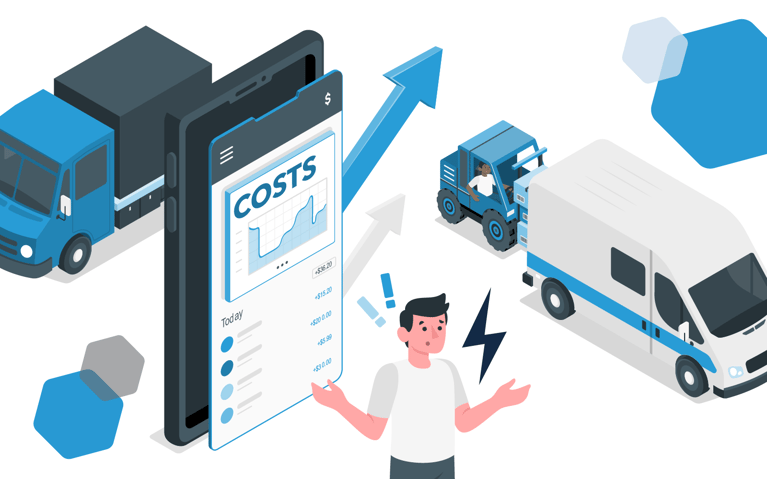Ecommerce customers move through the buyer’s journey based on a series of information they receive. They like a product, and the price is right – and then what? Conversion is also often dependent on shipping time and cost. A recent shipping survey found that shoppers overwhelmingly prefer free shipping to fast shipping but that 41% of consumers will pay shipping for a product they want, and 32% will proceed with an order if the cost is reasonable. Shipping costs require strategy – and the ability to calculate and estimate. If you don’t optimize shipping costs for you and the customer, it can affect profits and growth. In this article, we’ll walk you through the shipping process, strategies and how to calculate ecommerce shipping costs so you can make decisions that improve customer satisfaction without affecting your bottom line.
From order to doorstep: What influences shipping costs
Shipping is a complex process with many components. Orders come in, are processed, picked and packed, labeled and shipped. Each of those steps precedes the actual shipping and shipping cost per order.
Several factors influence the full cost of shipping a product:
Package dimensions and weight
Major carriers use a pricing calculation method called dimensional weight (DIM weight). It uses the size of your product – length x width x height – of the package or box size and divides it by a DIM divisor. However, if your package is heavy, weight will determine shipping. In other words, your package is evaluated by weight or dimensions, whichever affects the price more.
Destination
Shipping zones are the geographical areas that carriers use to calculate shipping rates. They are used to determine shipping costs and delivery timeframes based on distance. A package traveling coast to coast will cost more than one traveling to the next zip code.
Delivery timeframe
Current customer demands for short (even same-day) deliveries add a layer of complexity for ecommerce businesses. Shipping costs are based on delivery timeframes as well. Something sent 2- or 3-day shipping versus economy will cost more. And yet, expedited shipping has become an expectation, with 62% of shoppers expecting orders to arrive in less than three business days.
Shipping insurance and package contents
If your product is high value, you might add insurance. Other types of content also affect pricing, such as if an item is fragile. Insurance protects these items against loss, theft and damage.
Unexpected issues
Packages in transit can be affected by things outside your control. Weather, accidents and other random occurrences can delay or prevent a delivery. Brands must budget for potential shipping issues to ensure the customer experience is positive by resolving any problems swiftly.
How to charge for shipping
Shipping expenses are something brands should monitor constantly. Keeping track allows you to assess losses incurred by shipping costs and make strategic, informed decisions to offset them, especially when offering free shipping or running shipping promotions.
Today’s retailers must offer affordable shipping rates and provide seamless shipping experiences to satisfy their customers – and there are ways to determine shipping costs strategically. You can:
Decide on a shipping price strategy. Will you:
- Offer free shipping?
- Charge flat rates?
- Charge case by case?
- Offer free shipping after a certain order amount?
- Ship economy for free and charge for expedited?
- Give free shipping to loyalty members?
- Have shipping promotions during peak periods?
- Charge a customized rate for items with high DIM weights?
Determine speed and carrier. Will you:
- Ship economy or expedited? Will you charge more for expedited?
- Use ground or air?
- Use a 3PL service for fulfillment and shipping?
Ways to reduce shipping costs
Free shipping for all is a fantastic idea – but it’s not reasonable for every ecommerce brand. Instead, look for ways to reduce shipping costs so you can pass on those savings to your customers. Some of the best places to find savings are:
Decrease shipping distances
You instantly lower shipping costs when reducing the number of zones packages travel. You can do this using a multi-node fulfillment strategy, which allows you to distribute inventory nearer to customers. Multiple nodes can also shorten delivery timeframes, further improving the customer experience.
Offer flat-rate shipping
Flat-rate shipping charges a fixed shipping fee for the service if the item fits into the package dimensions provided. In addition, packing materials are often part of the shipping rate, making it a cost-effective option. A flat-rate shipping strategy can help you standardize costs, but it’s crucial to assess whether it’s a good fit given your current volume and product characteristics.
Reduce the weight and dimensions of your package
Analyzing your current packaging can help you find ways to reduce current dimensions and weight. For example, look for ways to rearrange, fold, flatten, vacuum seal or use custom-shaped packaging that minimizes the size. You can also reduce weight by using lighter-weight packing materials.
Consolidate shipments
Anytime you consolidate shipments or multiple orders, it may save you money. Sending an order in multiple shipments can cost more than just the shipping fee. You may also need to buy extra packaging materials for each shipment, which adds additional expenses. Customers often feel frustrated with split shipments, meaning you boost satisfaction when you consolidate as well.
Get discounted shipping rates
Often, there are perks to sending a high volume of packages. You can receive discounts by negotiating with carriers or utilizing their business solutions. Talking to different carriers is beneficial as well. Gathering information will allow you to make the best decision, even if it means moving to a competitor to save money.
Partner with a 3PL
For many ecommerce brands, looking at fulfillment and shipping as symbiotic is beneficial. At a certain point, your inventory is offsite and you’re have to manage a high volume of orders while shipping, tracking and replenishing stock.
Many 3PL services have access to wholesale rates. This is an instant save on shipping costs. Additionally, a 3PL partner with multiple fulfillment centers offers shorter transit times, giving you the ability to reduce shipping timeframes.
Optimize your shipping strategy with Cart.com
Shipping has become a critical part of the overall retail customer experience. They expect cost-effective, quick shipping -- meaning customer satisfaction should drive of your shipping strategy.
To learn more about 3PL and shipping costs, talk to our expert team today.

-1.webp?width=400)




